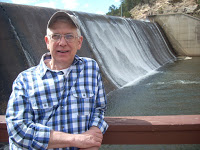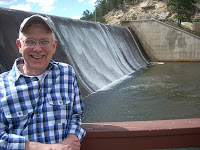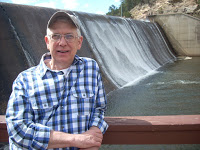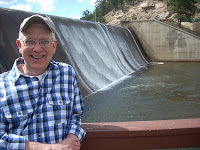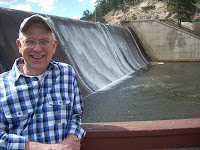I suppose we weren’t quite prepared for the mess although two summers ago Jim and I noticed the Honey Locust tree in the backyard was producing seedpods, a few of them. Last summer there were quite a few more. This summer the tree went crazy with its genetic demand to replicate and has produced hundreds of pods. They are not small, some measuring more than a foot in length and they hang in clusters of two to six. I thought them rather decorative like holiday ornaments. Our neighborhood squirrels showed up for the seasonal party and since the last week of August have gleefully begun their harvest.
If you know squirrels you realize they are as messy as teenagers, never cleaning up after themselves like the adolescent son in the comic strip Zits. I know about that because my daughter was one messy kid. Still is and so are her children. Luckily I don’t live nearby so I’m rarely irked by them. But the squirrels live here. They’re as cute as my grandkids and, like them, never give a thought about the consequences of their messes. The tree rats focus only on their preparation for the oncoming winter with its cold temperatures, snows, and otherwise harsh conditions that challenge rodent survival. I don’t blame them, but I do have to contend with what they leave behind. The squirrels live here and interest me. I watch and then grab the broom; my partner just gets mad.
A week ago Saturday I observed one of the three or four varmints who show up every day. She or he sat on a small branch harvesting. For twenty minutes the critter ate never having to prepare or even reach very far for its meal. She picked a pod, methodically removed the seeds, and dispensed with the rest. A pod landing on the clear plastic awning sounds like a low caliber rifle shot. The first hit was why I knew the squirrel was up there. I leaned back to watch. She chose a pod, worked it like I might an ear of corn except that she’d spit out the pod bites and keep only the seeds. When done in a few minutes or when she loses her grip, the pod falls. Bam. Then she may bite the stem of one of the compound leaves for a taste of something (perhaps flavoring) or strips off a bit of bark (her favorite) and then reaches for another pod. Perhaps due to my attention she soon jumped from that branch to another and disappeared from sight.
I began sweeping the patio a few days ago. Each day I pick up two or three hundred chewed-on pods and dump them by shovel fulls into the compost container. I tend to sweep when the sun gets low and the air begins to cool. The next morning reveals quite a few more pods on the patio, in flowering plants, sticker bushes, fountains, and on the awning. I hope this workout will be done before too many more days although I do get a bit of aerobic exercise and have improved my technique with the broom. But mostly I get a kick out of spotting our furry friends still at work high over head.
© 11 September 2017
About the Author
Phillip Hoyle lives in Denver and spends his time writing, painting, and socializing. In general he keeps busy with groups of writers and artists. Following thirty-two years in church work and fifteen in a therapeutic massage practice, he now focuses on creating beauty. He volunteers at The Center leading the SAGE program “Telling Your Story.”
He also blogs at artandmorebyphilhoyle.blogspot.com
